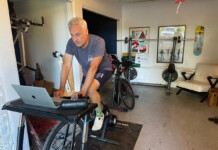By Dave Harward and Mark Deterline
Scientific parameters
Each time we suggest it’s time for a test, many of our athletes cringe and suggest postponing it until they feel better or stronger. Others love the challenge and look forward to it. Regardless, if an athlete wants the most out of structured training, especially if working with a qualified coach, we consider it indispensable.
In fact, we – along with many experts – believe that testing is key to improving your performance and should be undertaken 2-5 times per year, depending on how closely you’re tracking progress and fine-tuning your workouts.
As coaches and mentors, we need the results from VO2 max, lactate threshold and other tests for two primary reasons:
1- to establish your own personal benchmarks as well as ideal training parameters
2- to continually assess your progress and then adjust those parameters accordingly
As you’ve heard us explain in previous articles, training workloads provide the human organism with stimuli that effect adaptations in the body. In other words, as you physically cope with the stresses of specific workouts and events such as centuries or races, your body has the ability to adapt – i.e. become fitter and stronger.
The role of a coach is to determine what your body – and psyche – can handle and how hard to push both in order to not only make general fitness and strength gains, but to optimize those gains in the form of measurable improvements in performance.
A coach doesn’t necessarily need to test you in order to set you on a good path, but testing does make the process faster and more precise. Since the value proposition of coaching is to maximize your training time, testing is a potentially crucial component of success.
Benchmarking
We’ve watched other coaches flounder a bit, slow to establish an athlete’s ideal training zones and workload. When we’re asked “Why testing?” and “How often?” our responses are the same: So that a coach can know exactly where you are in order to best take you where you want to go.
By knowing your lactate threshold and VO2 max at the outset, a coach can immediately dial in a training plan suitable to your current level of fitness and based on your fitness or event objectives. Those tests are the quickest and most effective ways to get you off to a good start. But that’s just the start.
Measuring progress
As with anything else, it’s important to continually assess progress; you don’t want to take anything for granted or assume that everything is going as well as could be expected. By testing regularly throughout a progression cycle – such as a competitive or seasonal period – a coach can determine the effectiveness of prescribed workouts relative to the current, and hopefully improving, fitness level of an athlete. It gives coaches the ability to fine-tune training intensity and workload, accordingly.
Why test?
In summary, reasons for testing include:
• Continually establish baselines to ensure that training is optimized and that the athlete is on track.
• Verify scientifically that an athlete is both improving efficiency and increasing power output at the same “physiological cost”. This includes measurable improvement in lactate threshold numbers.
• Identify an athlete’s strengths and weaknesses in order to match them up with expectations and goals.
With cycling clients, we have the ability to develop power and fatigue profiles. Hunter Allen, Andy Coggan and Stephen McGregor have pioneered a variety of analysis protocols to guide coaches and their athletes through the process of determining strengths and weaknesses, as well as how to best address them.
Fatigue profiling is very useful. For example, we can create workouts that task athletes to put out neuromuscular sprint efforts (multiple, all-out sprints each 20 seconds in duration) that we break down into 20-second, 10-second and 5-second segments in order to assess where power output drops off. We assess a rider’s anaerobic profile through efforts of 2 minutes, 1 minute and 30 seconds. For VO2 max profiling we look at 8-minute, 5-minute and 3-minute efforts, and for threshold assessment we use segments of 90 minutes, 60 minutes and 20 minutes.
All such testing protocols help us build a comprehensive picture of a rider’s strengths, including how quickly power or efficiency drops off in specific circumstances so that we can prescribe training that will decrease “degradation” of performance in those situations.
Of course, testing should be done when an athlete has recovered from previous training sessions or events and is well rested. It is best performed with an athlete using her or his own equipment. There are often a variety of ways to conduct them, however subsequent tests should duplicate previous ones as far as procedural and material protocols. For cyclists, using a power meter will make the most of testing since the exact quantity of work can be determined.
Typical tests
• VO2 max: measures the maximum amount of oxygen your body is able to utilize to burn fuel. This is at maximal effort.
• Blood lactate threshold: this type of testing uses a device that measures the amount of lactate – a byproduct of exceeding aerobic ability to supply energy – in your blood. It is typically a submaximal test.
• Field testing – each protocol is up to the coach or athlete and can be performed indoors on exercise equipment or outside on a well suited road or trail. Ideally, you will be able to duplicate conditions from one test to another in order to compare results with a high level of reliability. We prefer to have athletes test indoors. In the case of cyclist clients, we set up their own bike on our CompuTrainer to accurately measure heart rate, power output, pedaling cadence, and left/right leg balance. A short, sustained effort (e.g. 10-mile time trial for cyclists) will provide sufficient data to build effective training zones.
• Training sessions – every workout is a test if you are recording exertion and output data.
Making it happen
Good coaching will help you reach your own personal performance, fitness and body composition goals, with emphasis on the word personal. In order to establish an optimal program for your unique body and state of fitness, however, there is nothing more helpful or accurate than a scientific snapshot of your physiology. It is the ultimate “before”, “during” and “after” imagery in training, and there are several testing facilities in Utah that provide such services.








